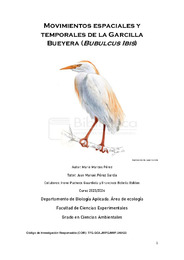Please use this identifier to cite or link to this item:
https://hdl.handle.net/11000/33415Full metadata record
| DC Field | Value | Language |
|---|---|---|
| dc.contributor.advisor | Pérez-García, Juan Manuel | - |
| dc.contributor.advisor | Pacheco, Irene | - |
| dc.contributor.advisor | Botella Robles, Francisco | - |
| dc.contributor.author | Marcos Pérez, Mario | - |
| dc.contributor.other | Departamentos de la UMH::Biología Aplicada | es_ES |
| dc.date.accessioned | 2024-10-04T07:57:24Z | - |
| dc.date.available | 2024-10-04T07:57:24Z | - |
| dc.date.created | 2024-06 | - |
| dc.identifier.uri | https://hdl.handle.net/11000/33415 | - |
| dc.description.abstract | La ecología del movimiento juega un papel crucial para entender cómo las diferentes especies se mueven e interactúan en su entorno. Ver cómo afectan estos movimientos a su comportamiento y supervivencia es crucial para la conservación de las especies. Las nuevas tecnologías GPS nos han permitido investigar aspectos antes desconocidos de la ecología animal. El conocer la ecología de una especie determinada nos puede ayudar a ver qué servicios ecosistémicos ofrece y cuan posibles efectos indirectos puede tener sobre el ecosistema. El estudio del movimiento de la garcilla bueyera mediante las nuevas tecnologías, algo antes nunca hecho, nos revela diferencias en el comportamiento de los individuos. Hasta ahora un ave muy poco estudiada en la ecología del movimiento, pero desde el reciente descubrimiento de su capacidad de transportar plásticos por medio de las egagrópilas desde los vertederos hasta los humedales, se han aumentado los esfuerzos por describirla y comprenderla. El estudio del movimiento de la garcilla bueyera en la provincia de Alicante, revela diferencias en el comportamiento entre individuos, dependiendo de si están en época de cría o no, así como entre sexos. La descripción de sus patrones de actividad, las distancias que son capaces de recorren y sus áreas de campeo serán cruciales para saber abordar múltiples factores para su protección y así desarrollar estrategias de conservación, tanto para ella como para los humedales. | es_ES |
| dc.description.abstract | Movement ecology plays a crucial role in understanding how different species move and interact in their environment. Understanding how these movements affect their behaviour and survival is crucial for species conservation. New GPS technologies have allowed us to investigate previously unknown aspects of animal ecology. Knowing the ecology of a given species can help us to see what ecosystem services it provides and what possible indirect effects it may have on the ecosystem. Studying the movement of cattle egrets using new technologies, reveals differences in the behaviour of individuals. So far, a little-studied bird in movement ecology, but since the recent discovery of its ability to transport rubber bands via pellets from landfills to wetlands, efforts to describe and understand it have increased. The study of cattle egret movements in the province of Alicante reveals differences in behaviour between individuals, depending on whether they are breeding or not, as well as between sexes. The description of their activity patterns, the distances they are able to travel and their roosting areas will be crucial in order to address multiple factors for their protection and thus develop conservation strategies, both for them and for the wetlands. | es_ES |
| dc.format | application/pdf | es_ES |
| dc.format.extent | 31 | es_ES |
| dc.language.iso | spa | es_ES |
| dc.publisher | Universidad Miguel Hernández de Elche | es_ES |
| dc.rights | info:eu-repo/semantics/openAccess | es_ES |
| dc.rights | Attribution-NonCommercial-NoDerivatives 4.0 Internacional | * |
| dc.rights.uri | http://creativecommons.org/licenses/by-nc-nd/4.0/ | * |
| dc.subject | Garcilla Bueyera | es_ES |
| dc.subject | ecología del movimiento | es_ES |
| dc.subject | tecnologías GPS | es_ES |
| dc.subject | Cattle Egret | es_ES |
| dc.subject | movement ecology | es_ES |
| dc.subject | GPS technologies | es_ES |
| dc.subject.classification | Ecología | es_ES |
| dc.subject.other | CDU::5 - Ciencias puras y naturales::57 - Biología::574 - Ecología general y biodiversidad | es_ES |
| dc.title | Movimientos espaciales y temporales de la Garcilla Bueyera (Bubulcus Ibis) | es_ES |
| dc.type | info:eu-repo/semantics/bachelorThesis | es_ES |

View/Open:
TFG-Marcos Pérez, Mario.pdf
1,33 MB
Adobe PDF
Share:
.png)
